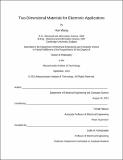| dc.contributor.advisor | Tomás Palacios. | en_US |
| dc.contributor.author | Wang, Han, Ph. D. Massachusetts Institute of Technology | en_US |
| dc.contributor.other | Massachusetts Institute of Technology. Department of Electrical Engineering and Computer Science. | en_US |
| dc.date.accessioned | 2014-02-10T17:00:26Z | |
| dc.date.available | 2014-02-10T17:00:26Z | |
| dc.date.issued | 2013 | en_US |
| dc.identifier.uri | http://hdl.handle.net/1721.1/84899 | |
| dc.description | Thesis (Ph. D.)--Massachusetts Institute of Technology, Department of Electrical Engineering and Computer Science, 2013. | en_US |
| dc.description | Cataloged from PDF version of thesis. | en_US |
| dc.description | Includes bibliographical references (pages 205-232). | en_US |
| dc.description.abstract | The successful isolation of graphene in 2004 has attracted great interest to search for potential applications of this unique material and other members of the two-dimensional materials family in electronics, optoelectronics and their interface with the biological systems. At this early stage of 2D materials research, many opportunities and challenges co-exist in this area. This thesis addresses the following issues which are crucial for 2D electronics to be successful, focusing on developing graphene for RF electronics and MoS2 for digital applications: (1) Development of some of the first graphene-based devices for high frequency applications; (2) Development of compact physical models for graphene transistors; and (3) Understanding the carrier transit delays in graphene transistors. In addition, this thesis proposes and experimentally demonstrates a completely new concept - Ambipolar Electronics - to take advantage of the unique properties of graphene for RF applications. Based on this new concept, a family of novel applications are developed that can significantly simplify the design of many fundamental building blocks in RF electronics, such as frequency multipliers, mixers and binary phase shift keying devices. In the last part of the thesis, the applications of other emerging 2D materials from the transition metal dichalcogenides family, such as molybdenum disulfide (MoS₂), is also explored for potential application in digital electronics, especially as a new material option for high performance flexible electronics. The future opportunities and potential challenges for the applications of the 2D materials family are also discussed. | en_US |
| dc.description.statementofresponsibility | by Han Wang. | en_US |
| dc.format.extent | 232 pages | en_US |
| dc.language.iso | eng | en_US |
| dc.publisher | Massachusetts Institute of Technology | en_US |
| dc.rights | M.I.T. theses are protected by
copyright. They may be viewed from this source for any purpose, but
reproduction or distribution in any format is prohibited without written
permission. See provided URL for inquiries about permission. | en_US |
| dc.rights.uri | http://dspace.mit.edu/handle/1721.1/7582 | en_US |
| dc.subject | Electrical Engineering and Computer Science. | en_US |
| dc.title | Two-dimensional materials for electronic applications | en_US |
| dc.type | Thesis | en_US |
| dc.description.degree | Ph.D. | en_US |
| dc.contributor.department | Massachusetts Institute of Technology. Department of Electrical Engineering and Computer Science | |
| dc.identifier.oclc | 868828146 | en_US |
